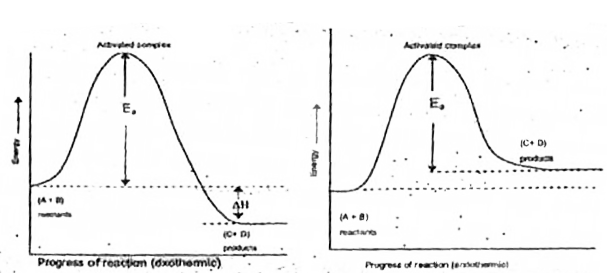A collision between high energy molecules overcomes the forces of repulsion and brings the formation of an unstable molecule cluster, called activated complex. The life span of an activatd complex is very small. Thus, the activated complex breaks either into reactants again or new substances, i.e. products. The activation energy (Ea) depends upon the nature of chemical bonds undergoing rupture and is independent of enthalpies of reactants and products. The energy changes during exothermic and endothermic versus the progress of the reaction are as shown below :

When temperature is increased, the number of active molecule increases, i.e. the number of effective collisions will increase and the rate of reaction will increase.
Activation energy (Ea)=E(activated complex)−E(ground state)
ΔH=Ea(f)−Ea(b)
The activation energy of exothermic reaction , A→B, is 80kJ. The heat of reaction is 200kJ. The activation energy for the reaction, B→A, will be
A
80kJ
B
120kJ
C
280kJ
D
200kJ
Text Solution
The correct Answer is:C
|
Topper's Solved these Questions
- CHEMICAL KINETICS AND RADIOACTIVITYBOOK - FIITJEECHAPTER - CHEMICAL KINETICS AND RADIOACTIVITYEXERCISE - Assignment problems (Objective) Level-II (Comprehension-V)
5 Videos
- CHEMICAL KINETICS AND RADIOACTIVITYBOOK - FIITJEECHAPTER - CHEMICAL KINETICS AND RADIOACTIVITYEXERCISE - Matching list type question
3 Videos
- CHEMICAL KINETICS AND RADIOACTIVITYBOOK - FIITJEECHAPTER - CHEMICAL KINETICS AND RADIOACTIVITYEXERCISE - Assignment problems (Objective) Level-II (Comprehension-III )
4 Videos
- CHEMICAL EQUILIBRIUMBOOK - FIITJEECHAPTER - CHEMICAL EQUILIBRIUMEXERCISE - MATCHING TYPE QUESTIONS
3 Videos
- CHEMISTRY IN EVERY DAY LIFE BOOK - FIITJEECHAPTER - CHEMISTRY IN EVERY DAY LIFE EXERCISE - ASSIGNMENT PROBLEMS (OBJECTIVE) Level - II (Numerical Based Questions)
5 Videos
Similar Questions
Knowledge Check
A collision between high energy molecules overcomes the forces of repulsion and brings the formation of an unstable molecule cluster, called activated complex. The life span of an activatd complex is very small. Thus, the activated complex breaks either into reactants again or new substances, i.e. products. The activation energy (Ea) depends upon the nature of chemical bonds undergoing rupture and is independent of enthalpies of reactants and products. The energy changes during exothermic and endothermic versus the progress of the reaction are as shown below :

When temperature is increased, the number of active molecule increases, i.e. the number of effective collisions will increase and the rate of reaction will increase.
Activation energy (Ea)=E(activated complex)−E(ground state)
ΔH=Ea(f)−Ea(b)
The activation energy for the forward reaction , X→Y, is 60kJmol−1 and ΔH is −20kJ/mol−1, the activation energy for the reverse reaction isA40kJ/molB60kJ/molC80kJ/molD20kJ/molThe Activation energy for a chemical reaction mainly depends upon
AtemperatureBnature of reacting speciesCconcentration of the reacting speciesDcollision frequencyThe Activation energy for a chemical reaction mainly depends upon
Athe difference in energies of reactants and productsBthe sum of energies of reactants and productsCthe difference in energy of intermediate complex with the average energy of reactantsand productsDthe difference in energy of intermediate complex and the average energy of reactants.
The Activation energy for a chemical reaction mainly depends upon
View SolutionEnergy of activation of a reactant is reduced by:
View SolutionThe chemical reactions in which reactants high amount of activation energy are generally
View SolutionEnergy of activation of a reactant is reduced by:
View SolutionThe chemical reactions in which the reactants require high amount of activation energy are generally
View Solution
